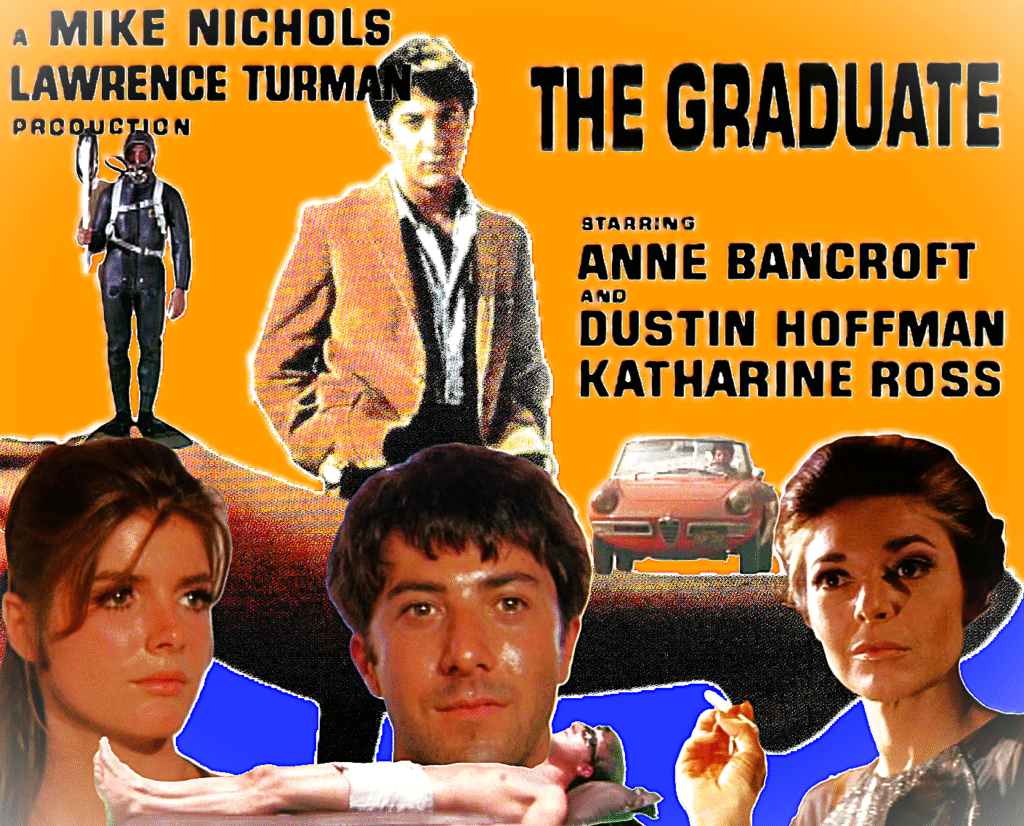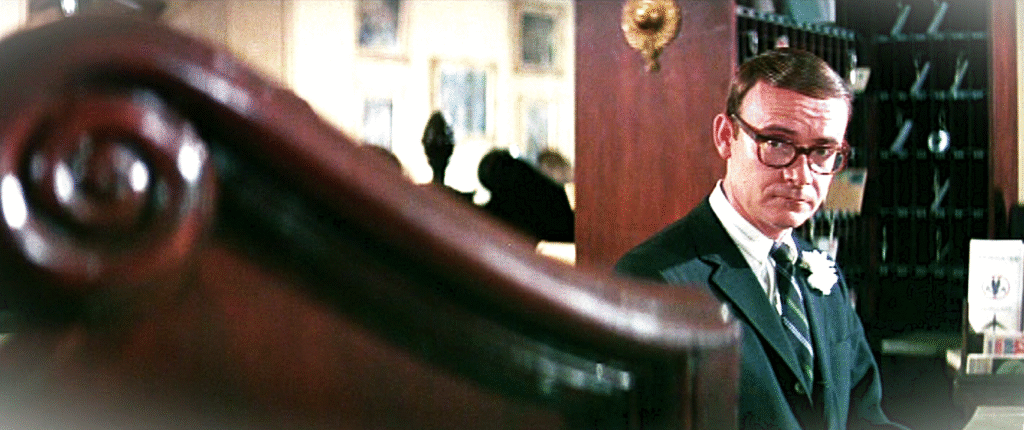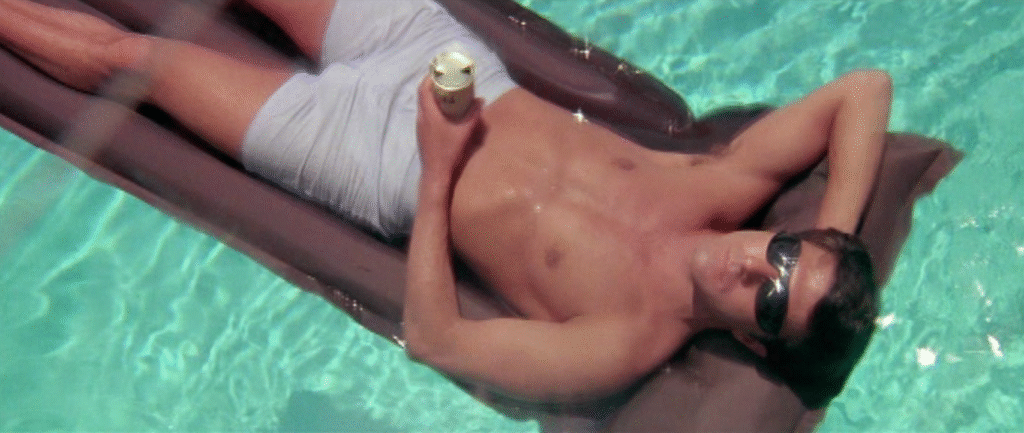THE MOVIE
Overview
Nominated for seven Oscars and winner of the Academy Award for Best Director, The Graduate by Mike Nichols is a classic of 1960s counterculture, maybe second only in popularity to Hopper’s Easy Rider, although the former is not always and unconditionally associated with the American hippy movement.

It all began with the already mentioned Orville Prescott’s bad review on Webb’s book which intrigued a young cinema producer named Lawrence Turman and sparked his interest in reading it. With little money spent to option the novel’s rights, Turman’s own money, he was on a mission to find a director and, most of all, the money to produce the movie.
After two years of rejections, he found the money although no one in Hollywood knew who Mike Nichols was and everybody who read the book did not find it funny at all. Joseph Edward Levine, known for being an aggressive salesman more than a film producer, had been contributing over the years to the release of dozens of b-movies such as Hercules, Godzilla, King of the Monsters! and Attila: he accepted the challenge and was guaranteed that the production could not exceed 1 million dollars.
The choices of the main actors in the movie to play the roles of respectively Benjamin Braddock and Mrs Robinson were meant to be originally Robert Redford and Ava Gardner, but fortunately for the huge success of the film itself the parts went to a little known thirty-year-old Jewish off-Broadway actor named Dustin Hoffman and a beautiful and charismatic Italian-American lady six years older, Anna Italiano, better known as Anne Bancroft, who was already the winner of an Academy Award for best actress.
With, in the end, a budget of three million dollars, the film was back in 1967 almost instantly a huge commercial success earning at the box office in North America only a gross of 105 million dollars.
The screenplay of the movie, we must say, possesses in its simplicity and linearity a great power as it helps the audience identifying with Benjamin or, at least, sympathise with his overwhelming and comical sense of disorientation towards a well-off and self-indulgent family and society at large that have little to none to offer to him and his future. This had to be credited mostly to Henry Buck who, as an actor and screenwriter himself (in the movie he is the Taft Hotel suspicious receptionist, see photo below), was not short of sense of humour; in fact, no wonder years later he became a multiple-time host of the highly popular comedy show Saturday Night Live.

As opposed to the book, the movie received positive reviews in terms of critics; they praised mainly the original directorial approach towards an anti-establishment material fit for the turbulent American 1960s and the humour the permeates the whole story alongside a lucid satire of the contemporary society, not to mention the disillusionment in both characters – as much outsider here as in the book – played superbly by Hoffman and Bancroft, being the former genuinely awkward while the latter bitter to the bone.
The soundtrack did the rest as we will see in a bit!
Well, I would say that I’m just drifting here in the pool
Forty minutes into the movie – running time is slightly more than 100 minutes – here we have a long sequence that starts in the pool and ends in the pool. It is the most creative and innovative moment in terms of script, direction and editing; this sequence truly represents an era (between the end of the sixties and the seventies) when the American cinema became a mordent satire on a mission to discredit a shallow society.
The previous scene, to have a better understanding of the chronology of events, had Benjamin and Mrs Robinson in their first clandestine affair at the Taft Hotel with the woman teasing the young graduate by asking him if that was his first time and by classing him as inadequate. Benjamin, outraged, orders her not to move and shuts the door of the hotel room: all is dark, so on a full black screen The Sound of Silence by Paul Simon can begin with one of the most popular opening lines in music history: “hello darkness, my old friend”.
A fade in to the crystal-clear and extremely bright water of the pool and a series of crossfades using that very element show us Benjamin, sunglasses on, chilling on the rubber raft under the sun while holding a can of beer. On a wider shot, we see his parents happily stocking a barbecue fire and Benjamin taking off his sunglasses, leaving the pool and putting on a white shirt to enter the house; when the door opens, he is in the hotel room and, while laid down on the bed against a black headboard, Mrs Robinson unbuttons his shirt and strokes his chest.
As the song progresses – there are no ambient sound or dialogues in order to create a real music video out of it – the next shot is a close-up of Benjamin which we take it as consequential as we still recognise the black headboard, but, when he gets off the bed, a can of beer still in his hand, to close the door and have some privacy, we find out he is in his house with his puzzled parents dining next door. Then he goes in front of the TV and sits down on a black sofa chair.
With another close-up of an increasingly bored Benjamin, the song ends to make room for another one arranged, this time, by both Paul Simon and Art Garfunkel (the traditional English ballad Scarborough Fair/Canticle): we are led to believe he is in the same environment drinking the same can of beer by the blackness behind him, but, when the camera zooms out, we discover him again in the hotel and in bed watching TV, on this occasion shirtless and under the sheets, with Mrs Robinson on and off-screen getting dressed and finally leaving the room.
We are then led to believe that the next close-up of an extraordinary Dustin Hoffman, as alienated as he could get, follows up on the previous shot by the black colour behind him, but, when the camera zooms out, we can locate him in his own room resting his head on a black cushion and smoking a cigarette. After peering through the blinds of the window, he stands up to put on a pair of boxers (no flashing images are shown) and grab a white towel to head to the swimming pool while walking past a baffled Mrs Braddock.
A dive into the water, a quick swim towards the rubber raft and Benjamin is in the next shot leaping in a bed on top of a beautiful and sophisticated Anne Bancroft in ecstasy; the music stops and the voice-off of Mr Braddock is heard saying: “Ben, what’re you doing?”
As placid and lay-back as he could get, Benjamin replies with the sun in his eyes: “Well, I would say that I’m just drifting here in the pool”. The spirit of the conversation between father and son in the book is reproduced intact here, but the screenplay consists of a much fewer lines quite entertaining and hilarious, though. Mr Braddock: “Have you thought about graduate school?” Benjamin: “No”. Mr Braddock:” Would you mind telling me then what were those four years of college for? What was the point of all that hard work?” demands Mr Braddock. Benjamin’s laconic reply is memorable: “You got me”.

Mr Braddock hardly controls himself: “Now listen, Ben. I think it’s a very good thing that a young man, after he’s done some very good work, should have a chance to relax and enjoy himself, and lie around, and drink beer and so on. But after a few weeks I believe that person would want to take some stock in himself and his situation and start to think about getting off his ass”.
Like in the book, the Robinsons also here are announced by Mrs Braddock, and the sequence ends.
WATCH IT!
This is one of those cases – there isn’t loads of them, in fairness – where the movie eclipses the book is based on, ergo Mike Nichol’s work is highly recommended. And it does not seem to lose its appeal as the years go by although, when you think of The Graduate, you picture the Sixties and the Sixties only in your mind’s eye…
Both DVD and the Blu-ray are quite affordable and there is a good choice of multiple editions but, at the end of the day, if you just want to watch the movie and don’t care much about 4k restoration, Dolby Digital 5.0, subtitles in various languages, dozens of extras, fine and elegant packaging and tigers on the cover, the cheaper Collector’s Edition (cardboard case!) by the Daily Mail could easily do the job! LINK/S
On the other hand, if you want to treat yourself or buy a present to someone special, bear in mind that the 50th Anniversary Edition has 2 discs: one with the main feature and audio commentaries by Dustin Hoffman and Mike Nichols, among the others, and the other one with, no jokes, all of this: The Graduate: Looking Back, Students of The Graduate, Mike Nichols: An American Master, Analysis Of Seduction Scene, About The Music, Screen Tests, Meeting With Author Charles Webb, Interview With Dustin Hoffman, Interview with Producer Lawrence Turman and The Graduate At 25. The great value for money formula is still there, though… LINK/S
Obviously, you can also buy or rent it on YouTube, Amazon Prime Video and Apple TV, too, where you can also have the chance to meet the tiger on the cover once again! LINK/S
